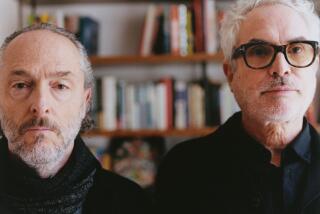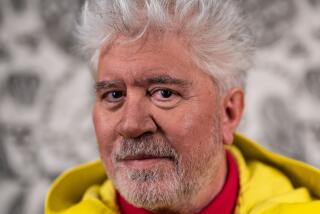Cult filmmakerâs bloody visions
As the first of a trio of his movies the Nuart is presenting over the next several days, Alejandro Jodorowskyâs âEl Topoâ seems just as pretentious and shallow as it did more than 35 years ago, but, then as now, it is understandable why it caught on as a cult film, helping launch the enduring popularity of the midnight-movie circuit.
The theater is promoting the 1971 film as âthe most talked-about, most shocking, most controversial quasi-Western head trip ever made.â That description is actually on the money, but it doesnât mean that one need agree even remotely with John Lennonâs opinion that âEl Topoâ is a masterpiece. Jodorowskyâs next film, âThe Holy Mountainâ (1973), which screens Tuesday through Thursday, by contrast stands the test of time surprisingly well.
âEl Topoâ is a dreary, protracted exercise in sadomasochism in which a stranger, El Topo (Jodorowsky), wandering across what seems to be a Mexican desert with his 7-year-old son (Jodorowskyâs actual son Brontis, naked except for a cowboy hat, the better to symbolize innocence), becomes a gunfighter after coming upon a massacred village. A dying man tells him that a certain colonel (David Silva) and his men are responsible for the slaughter, and El Topo exacts a gruesome revenge -- indeed, the entire film will be drenched in hideous bloodshed. In the process, El Topo, conveniently leaving his son with some Franciscan monks whose lives he has saved, takes up with the colonelâs beautiful young mistress Mara (Mara Lorenzio), from whom he hears that his quest in life is to defeat four desert holy men in their mind games. El Topo, who soon loses Mara to a fierce lesbian gunfighter (Paula Romo), is thus propelled on a spiritual quest in which he emerges as a Christlike figure who ends up in a frontier town. The filmâs climactic image is clearly drawn from one of the most indelible photos of the Vietnam War.
Until El Topo emerges as a holy man, shorn of his hair and beard, he cuts quite a figure in black leather -- cowboy hat, sleeveless duster over a black silk shirt, bellbottoms and designer boots -- the epitome of â70s counterculture male chic. Take off his hat and El Topo could have blended in at a Robert Altman house party of the era. El Topo is a kind of cross between Clint Eastwoodâs Man With No Name in the Sergio Leone westerns and Luis Bunuelâs pious priest in âNazarin.â Unfortunately, Jodorowsky is no Bunuel -- nor a Leone, for that matter -- and El Topoâs bloody odyssey, involving endless heavily symbolic encounters with the bizarre and fantastic, expresses the eternal tug of war between the savage and the spiritual in human nature on the most obvious level and in the most ponderous fashion.
Although it frankly didnât seem so at the time of its initial release, âThe Holy Mountainâ now looks to be a great leap forward for Jodorowsky. More than three decades later, Jodorowskyâs vision of chaos has acquired a powerful aura of prophecy. Jodorowsky loves to confront the viewer with endless brutality and grotesque decadence and degradation, but here he expresses it with a rich, densely visual imagination. âThe Holy Mountain,â a mystical, fevered dream of a movie, exists in a realm poised somewhere between buoyant Fellini fantasy and the bleak morbidity of Pasoliniâs âSalo.â
It opens with an exuberantly sacrilegious odyssey centering on the Thief (Horacio Salinas), a handsome, bearded Christlike figure clad only in a posing strap who ultimately encounters the Alchemist (Jodorowsky), who offers him shelter and respite -- and demonstrates his powers by turning feces into gold. The Thief thereby becomes involved in the Alchemistâs grand mission to redeem a group of monstrously rich or powerful individuals, requiring them to submit to redemption in return for immortality. It is the Alchemistâs intention to turn them into pilgrims who will eventually journey to Lotus Island, where they will climb the Holy Mountain and thereby displace the solar systemâs planets. The implication is that they would do a better job of overseeing mankindâs fate.
The group includes a chief of police with a passion for castration, a toy manufacturer with a penchant for turning out disguised weapons of mass destruction, a manufacturer of mattresses, instruments of pleasure and products promising the illusion of eternal youth -- each of the chosen individuals is engaged in destructive activities with a highly contemporary ring. Credit Jodorowsky with accurately envisioning myriad ways in which the Earth would grow drastically worse and increasingly dangerous and imperiled. The influence of Jodorowsky upon Alfonso Cuaron, Guillermo del Toro and Alejandro Gonzalez Inarritu and surely the artist-filmmaker Matthew Barney seems undeniable.
The Nuart is wisely relegating Jodorowskyâs âSanta Sangre,â a 1990 release, to a single midnight screening March 23. A grisly, lurid cross between âPsychoâ and the Tod Browning-Lon Chaney âThe Unknownâ -- for its circus setting and slicing off of arms -- it offers a mishmash of religious and Freudian symbolism amid torrential bloodshed topped with Fellini flourishes. It tells of a youth (Axel Jodorowsky) who suffered a mental breakdown after witnessing at age 8 his mother (Blanca Guerra) and father (Guy Stockwell), the gross, knife-throwing proprietor of the Circo Gringo, caught up in the most savage acts of revenge.
*
Films of Alejandro Jodorowsky. All unrated. Exclusively at the Nuart.
âEl Topo,â today through Monday. In Spanish with English subtitles. Running time: 2 hours, 4 minutes. âThe Holy Mountain,â Tuesday through Thursday. In English. Running time: 1 hour, 53 minutes. âSanta Sangre.â Midnight March 23. Running time: 2 hours, 3 minutes.
More to Read
Only good movies
Get the Indie Focus newsletter, Mark Olsen's weekly guide to the world of cinema.
You may occasionally receive promotional content from the Los Angeles Times.







